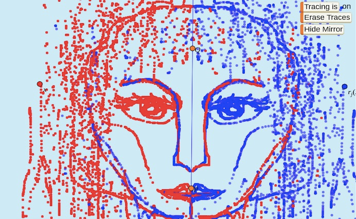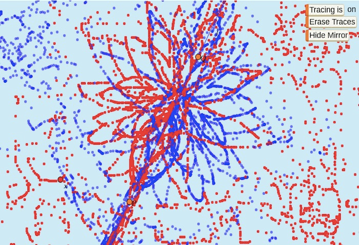
Introduction
Unit 1: Introducing Functions Geometrically
Identify Functions
In this lesson students distinguish independent from dependent variables, describe the behavior of dependent variables as they drag the independent variable, distinguish between functions and non-functions, and arrive at their own definition of function. The examples include some problematic cases, stimulating students' discussion and argumentation.
The Reflect Family
In this lesson students begin with a challenge of threading a maze. They create reflection designs, they play reflection games, they use restricted domains, and they describe reflections using function notation. Students create and perform original reflection dances.
Note the instructional design of the lesson web pages: everything is in one place, with the vanilla page showing the student the entire lesson outline in an easily-navigated format, and with support materials available for the teacher (T), an enhanced version with more background and pedagogical detail for the preservice teacher or PD workshop participant (P), and an additional level of support for the university professor or workshop facilitator (F).
Identify Function Families
In this lesson students drag variables to solve “Which one is different” puzzles involving four functions, three of which are from the same family. They begin by comparing the shapes of traces left by the variables, analyze the relationship between the traced shapes and the rate of change of the variables, and learn to distinguish functions based on rate of change. Students have their first encounter with function notation, as a way of indicating which dependent variable is related to which independent variable.
Reflect Family Results


The Rotate Family
In this lesson students create rotate functions, formulate informal descriptions of the rate of change that distinguishes rotate functions, use function notation, and restrict the domain of a rotate function to observe the corresponding range. Students perform physical and virtual function dances, they solve puzzles requiring them to rotate one shape to superpose it upon another congruent shape, and they use multiple rotations to create interesting designs. Students play a video game in which they're given three of the four elements of a rotate function (independent variable, center of rotation, angle of rotation, dependent variable), and their job is to find the value or location of the missing element.
Geometric-Function Dance Project
In this lesson students choreographed and video-recorded their own function dances incorporating the various transformations they studied in Unit 1.
Unit 2: Mystery Triangles
2a Demonstrate Congruence or Similarity
On each page, use a different transformations to superpose an image of `triABC` on `triDEF`.
You can use the designated transformation tool and adjust the function rule to superpose the two triangles. You may find the construction tools useful in this process.
Press the New Case button for a new `triABC` and a new function rule (still using the same function family).
How can the construction tools make it easier to solve new cases?
2b Choose the Function
On each page, you must first figure out what transformation connects the two triangles.
Then perform the necessary construction to superpose an image of `triABC` on `triDEF`.
Record the features you used, on each page, to identify the correct function to use.
Unit 3: Congruence Proofs by Construction
The full lesson on The SSS Theorem is here: /fc/unit3/prove-sss/?user=teacher
3a Segment Congruence
If two segments are of equal length, how can we prove that one segment can be superposed on the other?
3b SSS Triangle Congruence
If two triangles have corresponding sides that are equal in length, how can we prove that one triangle can be superposed on the other?
- On page 1, use reflect functions to superpose `A` on `D`, and then to superpose `B'` on `E`, and finally `C''` on `F`. What do you observe?
- On page 2, the two triangles don't begin with equal-length sides. What goes wrong when you try to use the same sequence of three reflections to superpose these triangles? What else must you do to make the construction successful? Why does this work?
- On page 2, how can you use the history boxes to explain why the Side-Side-Side Theorem must be true?
- On page 3, the triangles are arranged as they were on page 1, with their corresponding sides of equal length, but this time the `triABC` and `triDEF` have the same handedness. (On pages 1 and 2, they had opposite handedness.) What happens if you try to use the same proof construction as you used on page 2? Is there any way you can prepare `triABC` so that the page 2 construction does work?
- On page 4, the two triangles have the same handedness, but they don't start with the corresponding sides equal in length. On this page prepare `triABC` so that you can use the same steps as on page 2 to superpose the image of `triABC` on `triDEF`.
- On page 5, you'll encounter a different problem when you try to use the three-reflection method from page 2. How can you prepare `triABC` on this page so that the three-reflection method will work normally?
Recent WSP Enhancements
Widgets
- The style widget allows the user to change the style and color of an object.
- The text widget allows the user to change the label of an object.
- The visibility widget allows the user to show or hide an object.
Upload/Download
The new Utility menu has commands that allow the user to upload a sketch (as a .json document) from their computer, and to download a sketch from a web page to their computer.
Tool Library
The Tool Library enables the user to modify a websketch by adding, removing, or reordering the tools in the sketch.
Sketch Viewer
The Sketch Viewer enables a teacher to load multiple sketches into the sketch-viewer web page to display and interact with students' work:
The Fine Print
Requirements:
These activities require web access using a browser that supports HTML5 and JavaScript. (That means almost any current browser.) No purchase is required, and there’s no advertising anywhere.
Release Information
[an error occurred while processing this directive]Update History:
Record every major revision, in reverse chronological order
24 Jan 2018: Created this lesson template.

